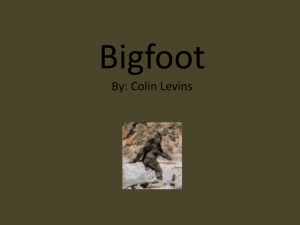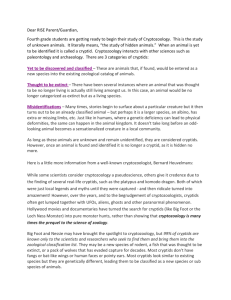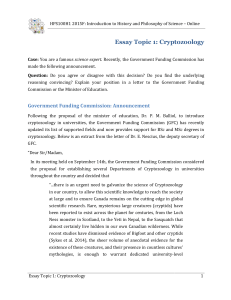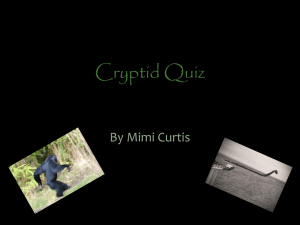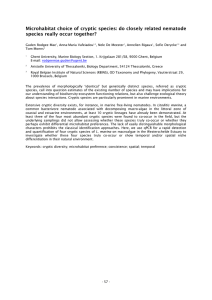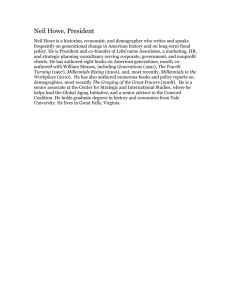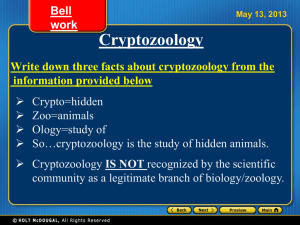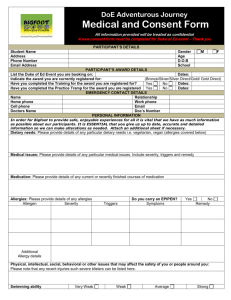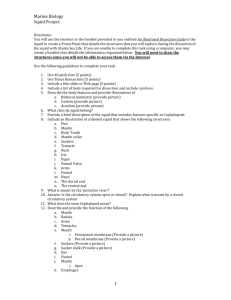Topics For Earth Sciences 083F
advertisement
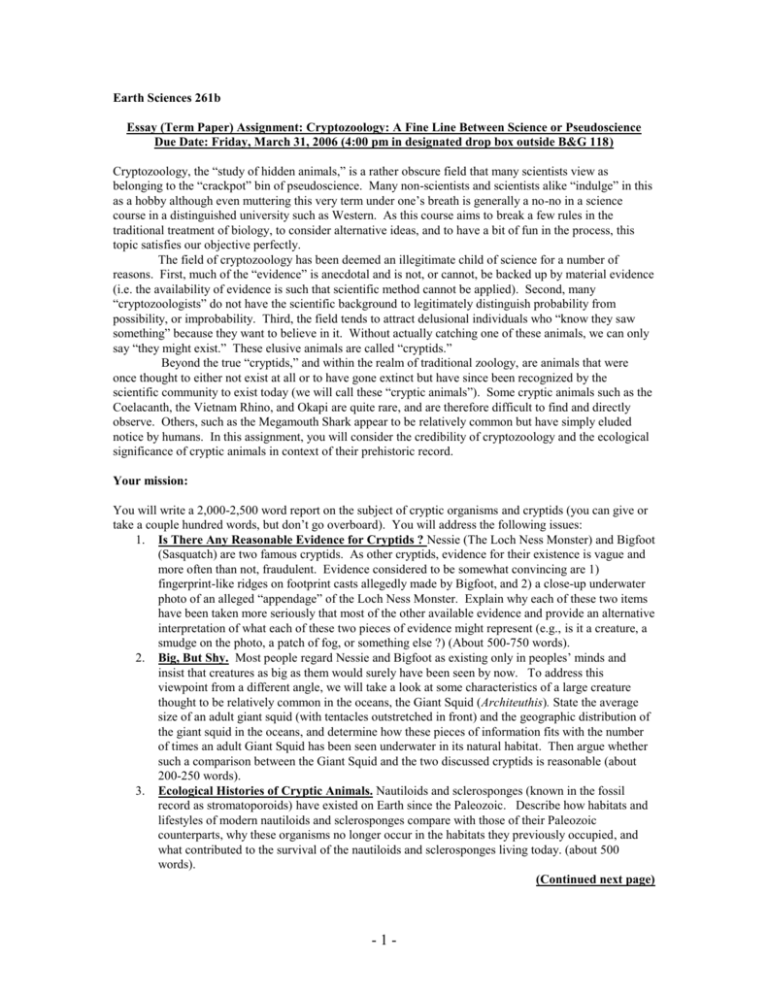
Earth Sciences 261b Essay (Term Paper) Assignment: Cryptozoology: A Fine Line Between Science or Pseudoscience Due Date: Friday, March 31, 2006 (4:00 pm in designated drop box outside B&G 118) Cryptozoology, the “study of hidden animals,” is a rather obscure field that many scientists view as belonging to the “crackpot” bin of pseudoscience. Many non-scientists and scientists alike “indulge” in this as a hobby although even muttering this very term under one’s breath is generally a no-no in a science course in a distinguished university such as Western. As this course aims to break a few rules in the traditional treatment of biology, to consider alternative ideas, and to have a bit of fun in the process, this topic satisfies our objective perfectly. The field of cryptozoology has been deemed an illegitimate child of science for a number of reasons. First, much of the “evidence” is anecdotal and is not, or cannot, be backed up by material evidence (i.e. the availability of evidence is such that scientific method cannot be applied). Second, many “cryptozoologists” do not have the scientific background to legitimately distinguish probability from possibility, or improbability. Third, the field tends to attract delusional individuals who “know they saw something” because they want to believe in it. Without actually catching one of these animals, we can only say “they might exist.” These elusive animals are called “cryptids.” Beyond the true “cryptids,” and within the realm of traditional zoology, are animals that were once thought to either not exist at all or to have gone extinct but have since been recognized by the scientific community to exist today (we will call these “cryptic animals”). Some cryptic animals such as the Coelacanth, the Vietnam Rhino, and Okapi are quite rare, and are therefore difficult to find and directly observe. Others, such as the Megamouth Shark appear to be relatively common but have simply eluded notice by humans. In this assignment, you will consider the credibility of cryptozoology and the ecological significance of cryptic animals in context of their prehistoric record. Your mission: You will write a 2,000-2,500 word report on the subject of cryptic organisms and cryptids (you can give or take a couple hundred words, but don’t go overboard). You will address the following issues: 1. Is There Any Reasonable Evidence for Cryptids ? Nessie (The Loch Ness Monster) and Bigfoot (Sasquatch) are two famous cryptids. As other cryptids, evidence for their existence is vague and more often than not, fraudulent. Evidence considered to be somewhat convincing are 1) fingerprint-like ridges on footprint casts allegedly made by Bigfoot, and 2) a close-up underwater photo of an alleged “appendage” of the Loch Ness Monster. Explain why each of these two items have been taken more seriously that most of the other available evidence and provide an alternative interpretation of what each of these two pieces of evidence might represent (e.g., is it a creature, a smudge on the photo, a patch of fog, or something else ?) (About 500-750 words). 2. Big, But Shy. Most people regard Nessie and Bigfoot as existing only in peoples’ minds and insist that creatures as big as them would surely have been seen by now. To address this viewpoint from a different angle, we will take a look at some characteristics of a large creature thought to be relatively common in the oceans, the Giant Squid (Architeuthis). State the average size of an adult giant squid (with tentacles outstretched in front) and the geographic distribution of the giant squid in the oceans, and determine how these pieces of information fits with the number of times an adult Giant Squid has been seen underwater in its natural habitat. Then argue whether such a comparison between the Giant Squid and the two discussed cryptids is reasonable (about 200-250 words). 3. Ecological Histories of Cryptic Animals. Nautiloids and sclerosponges (known in the fossil record as stromatoporoids) have existed on Earth since the Paleozoic. Describe how habitats and lifestyles of modern nautiloids and sclerosponges compare with those of their Paleozoic counterparts, why these organisms no longer occur in the habitats they previously occupied, and what contributed to the survival of the nautiloids and sclerosponges living today. (about 500 words). (Continued next page) -1- 4. 5. Could Cryptids Be Survivors ? Many cryptozoologists support the hypothesis that, like nautiloids and sclerosponges, Nessie and Bigfoot are surviving members of ancient animal groups. State what ancient animals the Loch Ness Monster and Bigfoot would most likely represent if this were the case and a reasonable explanation for how they might have ended up living in the places in which they are claimed to exist. (about 500 words). Old, But New. Provide an example of a new animal species (presently living today), excluding species of microbes, discovered within the past ten years (i.e. were unknown to science prior to 1996) and discuss how its discovery has altered the way scientists view the biological group to which it belongs (about 250 words). In addition to the material in the the main body of the essay outlined about, provide an introduction (about 100 words), explaining the format of your report and a conclusion (about 100 words) represented as a synthesis of the most significant points in your report and what you feel as the “bottom line” (i.e. ultimate message) of this assignment. Marking Criteria Your mark will be primarily based on the content of your report, but your grade will also be greatly influenced by your organizational and writing abilities (yes, this does include spelling and grammar). Reports should be broken into appropriate sections as indicated above (i.e. “Introduction” and “Conclusions”, with appropriate subheadings listed in between- as described above). Include a title page at the beginning of the report and a “References” section at the end of the document. All essays should be double-spaced and typed in 12-point font. Reports showing any evidence of plagiarism will be given a grade of zero. Also note that the information you have collected for your report should be paraphrased in your own words. Avoid using direct quotations unless such a quotation is critical to the subject being discussed . Avoid using footnotes; instead, use the reference format provided below. Essays that have depended heavily on lecture materials without further research will be penalized for lack of effort to seek out additional information. All information, quoted or paraphrased, that is not simple common knowledge MUST be properly cited and referenced. Submission Requirements and Deadline Submit your report in the labeled drop box for ES261b at 4:00 pm, Friday, March 31, outside B&G Rm. 118. If you want to hand the assignment in before this time, by all means do so ! Reports handed in after the prescribed time and date will be counted late. Late assignments will be deducted 10 % per day (assignments handed in on the prescribed date but after the prescribed time at the prescribed location will be automatically counted as 1 day late). The weekend will be counted as a single day. Illustrations You are encouraged to use pictures to illustrate your point. When you use a picture, you must refer to the corresponding figure number in the text of your report. Example of how a figure should be referred to in the text Diamond is made of carbon atoms that are arranged in a specific three-dimensional pattern (Figure 1). Each picture should be assigned a figure number and caption, with a reference to the original source of the picture. Example of a figure caption: Figure 1: The internal arrangement of carbon atoms within the crystal structure of diamond (from Hildebrand, 1984). -2- Citations in Text Properly cite information used in the text of your essay. For articles with more than one author, write the last name of the first author, followed by “et al.” Hard-copy and authored internet articles For hard-copy publications and , cite the last name(s) of authors, followed by year of publication. Example sentence: The effects of volcanic ashfall on marine communities are well-documented (Radinsky, 1987; Fredrickson and Olstott, 1996; Heikoop et al., 1996). Another example sentence: As documented by Radinsky (1987), Frederickson and Olstott (1996) and Heikoop et al. (1996), volcanic ashfall can profoundly affect the heath of marine communities. Yet another example sentence (this one is for an authored internet article): Research on the martian meteorite ALH84001 has provided intriguing evidence for possible ancient life on Mars (McKay et al., 1996). Unauthored internet articles If using a website article without an author, give an appropriate title (e.g. Mt. St. Helens Article, Discovery Channel Website). A Note on Quotations As stated above, you are discouraged from using direct quotations; wherever possible, express the concepts in your own words. If you that feel that a quotation is absolutely necessary, provide a citation as indicated above, followed by the page number of the publication you derived the quotation from (e.g., Heikoop et al., 1996, p. 287). If using an unauthored internet article, cite it as indicated above - a page number is not necessary. Remember all information that is not your own, quoted or paraphrased, must be properly cited and referenced. A Note on References Citations in the text and figure captions of your essay should correspond with full citations in a “References” section at the end of your report. This should be divided into the subheadings “Hard-copy publications and authored internet publications” and “Unauthored internet articles” These should be listed in alphabetical order (according to last name of author or title of webpage). Your references should conform as closely as possible to the following format: Hard-copy publications and authored internet articles 1) For scientific journal articles: Heikoop, J.M., Tsujita, C.J., Risk, M.J., and Tomascik, T., 1996, Corals as proxy recorders of volcanic activity: evidence from Banda Api, Indonesia. Palaios, v. 11, p. 286-292. 2) For books: Radinsky, L.B., 1987, The Evolution of Vertebrate Design. The University of Chicago Press, Chicago, 188 p. 3) For articles in popular magazines: Fredrickson, J.K., and Onstott, T.C., 1996, Microbes deep inside the Earth. Scientific American, October, p. 68-73. 5) For articles in compendia: Kidwell, S.M., and Bosence, D.J.W., 1991, Taphonomy and time -averaging of marine shelly faunas. In: Allison, P.A. and Briggs, D.E.G., eds., Taphonomy: Releasing the Data Locked in the Fossil Record. Plenum Press, New York, p. 115-209. 6) For articles in conference symposia: Buddemeier, R.W., 1974, Environmental controls over annual and lunar monthlycycles in hermatypic coral. Proceedings of the Second International Symposium on Coral Reefs, v. 2, Great Barrier Reef Committee, Brisbane, p. 259-267 -3- 7) For authored website articles McKay, D.S., Gibson, E.K., Thomas-Keprta, K.L., and Vali, H., 1996, Search forpast life on Mars: possible relic biogenic activity in Martian meteorite ALH84001. Lunar and Planetary Institute website, http://cass.jsc.nasa.gov/lpi.html. Accessed February 19, 2005. Unauthored internet articles: If an author is not provided on the website, use the appropriate title cited in the text and give the full address of the website source you obtained the information from, plus the date at which the article was accessed. For example: Mt. St. Helens article, Discovery Channel website, http://dsc.discovery.com/news/afp/20041004/helens.html. Accessed February 20, 2005. Pearls article, American Museum of Natural History website, http://www.amnh.org/exhibitions/pearls/. Accessed February 21, 2005. -4-
